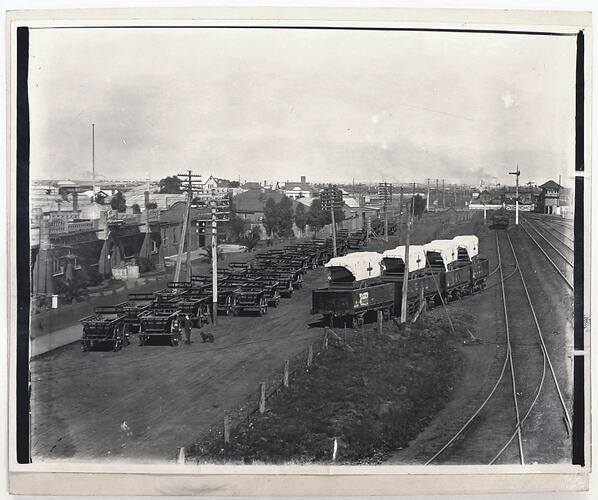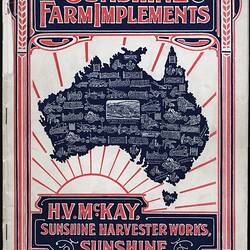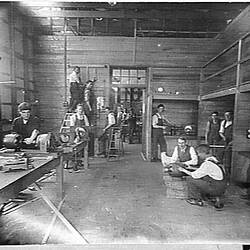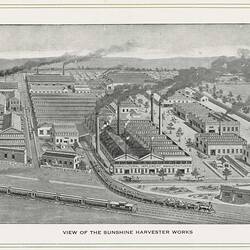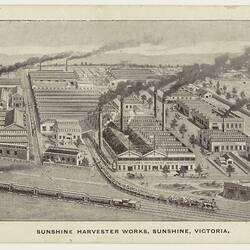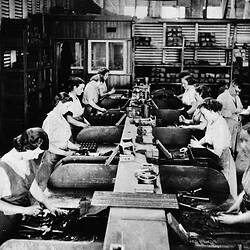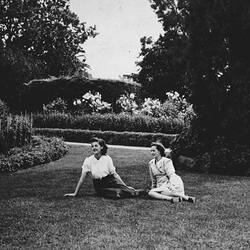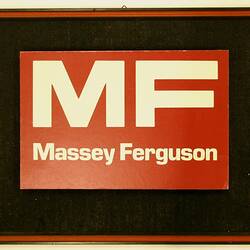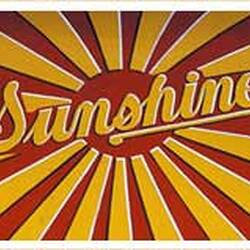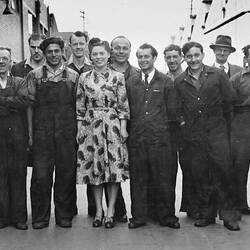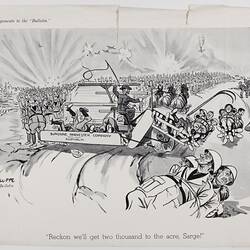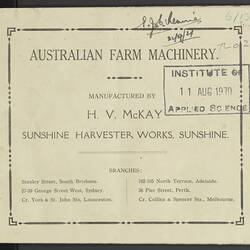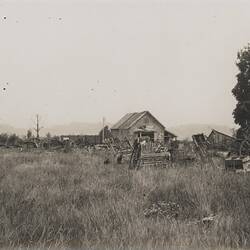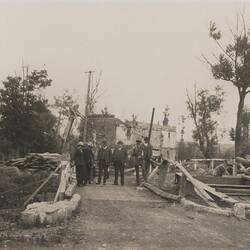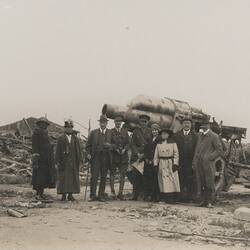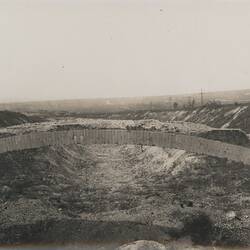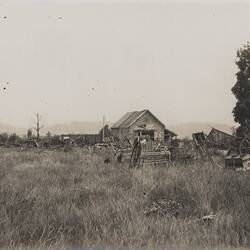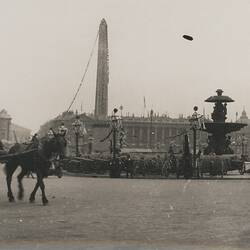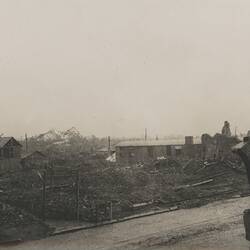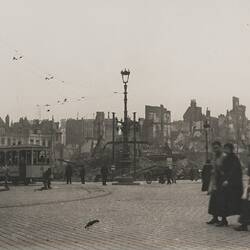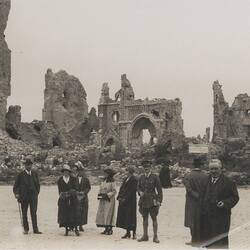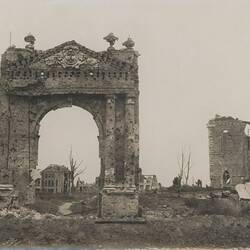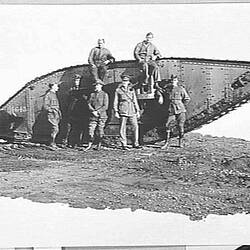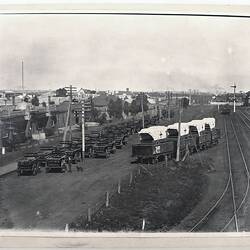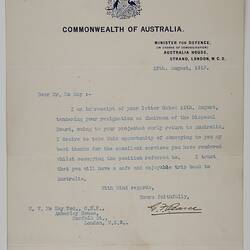Summary
Sunshine Harvester Works' contributions to World War I, including the production of ammunitions and vehicles, employees who signed up as servicemen and assistance to returned soldiers.
During World War I production at the Sunshine Harvester Works focused on manufacturing military equipment and weapons for the Department of Defence. The factory produced ambulances, general service wagons and Furphy water carts. It also manufactured weaponry and other items including trenching tools, hand grenades, lathes for making shell harness mountings and large quantities of horseshoes and chains. The factory operated day and night to create war-related equipment. Factory employee Howard 'Bushy' Thompson recalled working from 6:30am until 11:30pm making implements. He also remembered H.V McKay and his brother George riding around the factory on horseback once a week, checking progress and chatting with factory foremen.
Over a four week period, the factory produced 200 wagons, 23 ambulances and 150 water carts for the Australian Expeditionary Forces. Additional axles were created at Sunshine Harvester Works when those ordered from Sydney and Adelaide were insufficient. This was the first time that the factory had produced wagons. Proud of this achievement, McKay exhibited a sample wagon and water cart at the Melbourne Showgrounds in September 1914. The Argus praised the quality of the machinery produced by the factory. The ambulances were described as being 'very elaborate' as they were 'fitted with all conveniences in the way of medical appliances', while the water carts could carry 150 gallons. Similarly, the general service wagons were 'sturdily built' and included updated features such as two brakes and 'special swingletrees encased in steel' (The Argus, 23 Sept. 1914, p.16).
Work at the factory during the war presented new opportunities for some women. One woman was engaged to carry out manual work in the factory, though much to the dissatisfaction of the Implement Makers' Union.
As well as overseeing the factory's war productions, H.V McKay served on official committees which were established to advise the government about weapons manufacturing. Together with his brother Sam, McKay sat on the Federal Munitions Committee which was created in 1915. In addition, he was on the Board of Business Administration which was formed in 1918 to advise the Department of Defence on the contract and supply of equipment for the war. While in London he chaired the Australian War Materials Disposal Board in 1919. McKay was appointed CBE for his wartime work.
Many Sunshine Harvester Works employees served in the Australian military. At least 35 workers enlisted in the army in 1914 and by 1917, 250 employees were in battlefields across Europe. These men included workers from the company's offices in Sunshine, Sydney, Brisbane, Perth, Adelaide and Argentina. Of these troops, 15 were killed, 28 were wounded and two missing. The company's apprentices were particularly enthusiastic about enlisting as 40% had joined in 1918. Members of H.V McKay's family also fought in the war, including nephew Victor who travelled from Argentina to join the British army and son Cecil who enlisted in the Australian Flying Corps. Gavin, H.V McKay's youngest brother, served in the Australian Light Horse in present-day Iraq and France before returning to his Drummartin farm following the war. Several months spent in appalling conditions in French trenches resulted in Gavin developing a limp which he carried for the rest of his life.
The McKay family suffered a tragic loss in November 1916 when Corporal Alan McKay (H.V McKay's nephew and the son of Nathaniel and Emma McKay) was killed in Gueudecourt, France. He was part of the Australian Imperial Force's 46th Battalion. Other casualties from the war included factory assembler Squadron Quartermaster Sergeant John Stewart who was killed at Gallipoli in July 1915. Stewart fought in the Light Horse and was subsequently buried in Shell Green Cemetery near Anzac Cove. The Stewart family were closely connected to the First World War as three of the nine sons were enlisted in the army. At the time of his father's death, eldest son Donald was serving the military, while brothers Colin and Alex were in training at the Melbourne Showgrounds.
Company employees who did not enlist in the army assisted their military colleagues in other ways. They worked extended hours to produce weaponry for the Australian forces and contributed money to the Sunshine Patriotic Fund which was established by Factory Superintendent George McKay. The Fund's committee also organised concerts and other entertainment for Sunshine locals to raise money for soldiers. In August 1917, the Sunshine Harvester Works unveiled its Honour Board during a tree-planting ceremony in Sun Crescent, Sunshine to commemorate local soldiers who had gone to war.
Returned soldiers received assistance from the company. When the Sunshine Technical School began training returned soldiers in 1917, the Sunshine Harvester Works offered employment and course materials. The firm also purchased goods made by students and loaned equipment. The scheme ended in 1920 after 200 soldiers had been trained. George McKay and his wife Jessie also organised an afternoon tea for 120 wounded soldiers in the Sunshine Gardens. In 1918, 100 employees worked extended shifts to produce articles for the Returned Soldiers' Fair and for the Red Cross. The following year, McKay sold a portion of his land in Sunshine to the Federal Government to create a soldier settlement. The area eventually became present-day Albion.
The factory was also important in delivering war news to locals. On the evening of November 11, 1918 Sunshine residents were startled by the sound of whistles and bells ringing from the Sunshine Harvester Works. People flocked to the factory thinking there was a fire, however they quickly learned of the good news; the war was over. During the night, residents celebrated by playing music and holding processions in town. Workers at the factory were given a holiday the following day.
- References
- Sunshine Outlook 1962,'"Bushy" Quits and "Goes Bush"', vol. 1, no. 4, pp.8.
- 'Wagons for the Forces: Smart Work at Sunshine', 1914, The Argus, 23 September, p.16.
- 'Women in Iron Trade: Trades Hall Perturbed', 1916, The Argus, 29 July, p.18.
- Ford, O & Vines G in association with Graeme Butler and Francine Gilfedder 2000, Brimbank City Council Post-contact Heritage Study: Environmental History, Volume 1. Brimbank City Council, viewed 20 March 2013,http://www.brimbank.vic.gov.au/Our_Services/Building_Planning_Engineering/Strategic_Planning/Our_Heritage
- Ford, O 2001. Harvester Town: The Making of Sunshine, 1890-1925, Sunshine and District Historical Society, Sunshine.
- Lack, J 1986, 'McKay, Hugh Victor (1865-1926)', Australian Dictionary of Biography. Melbourne University Press, Melbourne, viewed 20 March 2013, http://adb.anu.edu.au/biography/mckay-hugh-victor-699
- McNeil, D and the McKay Family 1984, The McKays of Drummartin and Sunshine: Their Personal Story, ppublished privately for the H.V McKay Reunion.
More Information
-
Keywords
World War I, 1914-1918, Munitions, Returned Soldiers, Arms & Armour, Weapons, Conscription, Agricultural Workers, Agricultural Equipment
-
Authors
-
Article types
